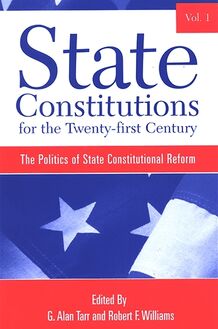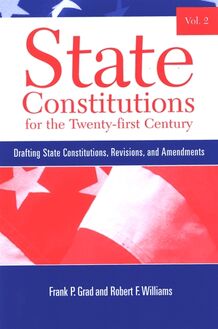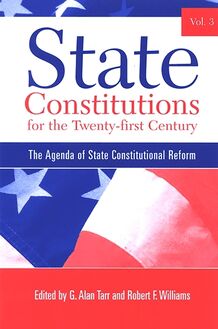-
 Univers
Univers
-
 Ebooks
Ebooks
-
 Livres audio
Livres audio
-
 Presse
Presse
-
 Podcasts
Podcasts
-
 BD
BD
-
 Documents
Documents
-
- Cours
- Révisions
- Ressources pédagogiques
- Sciences de l’éducation
- Manuels scolaires
- Langues
- Travaux de classe
- Annales de BEP
- Etudes supérieures
- Maternelle et primaire
- Fiches de lecture
- Orientation scolaire
- Méthodologie
- Corrigés de devoir
- Annales d’examens et concours
- Annales du bac
- Annales du brevet
- Rapports de stage
La lecture à portée de main
226 pages
English
Découvre YouScribe en t'inscrivant gratuitement
Je m'inscrisState Constitutions for the Twenty-first Century, Volume 1 , livre ebook
Découvre YouScribe en t'inscrivant gratuitement
Je m'inscris
Obtenez un accès à la bibliothèque pour le consulter en ligne
En savoir plus
En savoir plus
226 pages
English
Obtenez un accès à la bibliothèque pour le consulter en ligne
En savoir plus
En savoir plus

Description
Through illuminating case studies of reform efforts in Alabama, California, Colorado, Florida, New York, and Virginia, this book—the first of three volumes—provides the first systematic analysis of the political obstacles to state constitutional reform. For those seeking constitutional reform, this useful resource can spell the difference between success and failure, and for those interested in state politics or constitutional politics, it offers rare insight into a distinctive aspect of American constitutionalism. Written by eminent scholars who were, in many cases, also active participants in the reform campaign, the essays provide practical experience, expert analysis, and lessons for future constitutional reformers.
Introduction
G. Alan Tarr
PART I: Constitutional Commissions and Constitutional Reform
1. Constitutional Revision in Florida: Planning, Politics, Policy, and Publicity
Rebecca Mae Salokar
2. Constitutional Revision in California: The Triumph of Amendment over Revision
Bruce E. Cain
3. Adopting a New Constitution: Lessons from Virginia
A. E. Dick Howard
PART II: Putting Constitutional Reform on the Agenda
4. Constitutional Reform in Alabama: Long Time in Coming
H. Bailey Thomson
5. The Mandatory Constitutional Convention Question Referendum: The New York Experience in National Context
Gerald Benjamin
6. Direct Democracy and Constitutional Reform: Campaign Finance Initiatives in Colorado
Anne G. Campbell
Appendix: Mechanisms for State Constitutional Change
Contributors
Index
Introduction
G. Alan Tarr
PART I: Constitutional Commissions and Constitutional Reform
1. Constitutional Revision in Florida: Planning, Politics, Policy, and Publicity
Rebecca Mae Salokar
2. Constitutional Revision in California: The Triumph of Amendment over Revision
Bruce E. Cain
3. Adopting a New Constitution: Lessons from Virginia
A. E. Dick Howard
PART II: Putting Constitutional Reform on the Agenda
4. Constitutional Reform in Alabama: Long Time in Coming
H. Bailey Thomson
5. The Mandatory Constitutional Convention Question Referendum: The New York Experience in National Context
Gerald Benjamin
6. Direct Democracy and Constitutional Reform: Campaign Finance Initiatives in Colorado
Anne G. Campbell
Appendix: Mechanisms for State Constitutional Change
Contributors
Index
Sujets
Informations
| Publié par | State University of New York Press |
| Date de parution | 01 juin 2006 |
| Nombre de lectures | 0 |
| EAN13 | 9780791482452 |
| Langue | English |
| Poids de l'ouvrage | 1 Mo |
Informations légales : prix de location à la page 0,1648€. Cette information est donnée uniquement à titre indicatif conformément à la législation en vigueur.
Extrait
Vol. 1 CSontstiatutioens for the Twentyfirst Century
The Politics of State Constitutional Reform
Edited By G. Alan Tarr and Robert F. Williams
State Constitutions for the Twentyfirst Century
Vol. 1
SUNY series in American Constitutionalism Robert J. Spitzer, editor
State Constitutions for the Twentyfirst Century
Vol. 1
The Politics of State Constitutional Reform
Edited by G. Alan Tarr and Robert F. Williams
State University of New York Press
Published by State University of New York Press, Albany
© 2006 State University of New York
All rights reserved
Printed in the United States of America
No part of this book may be used or reproduced in any manner whatsoever without written permission. No part of this book may be stored in a retrieval system or transmitted in any form or by any means including electronic, electrostatic, magnetic tape, mechanical, photocopying, recording, or otherwise without the prior permission in writing of the publisher.
For information, address State University of New York Press, 194 Washington Avenue, Suite 305, Albany, NY 122102384
Production by Michael Haggett Marketing by Anne M. Valentine
Library of Congress CataloginginPublication Data
The politics of state constitutional reform / edited by G. Alan Tarr and Robert F. Williams. p. cm. — (State constitutions for the twentyfirst century ; v. 1) (SUNY series in American constitutionalism) Includes bibliographical references and index. ISBN 0791466132 (hardcover : alk. paper) 1. Constitutional law—United States—States. 2. Law reform—United States— States. I. Tarr, G. Alan (George Alan) II. Williams, Robert F. III. Series. IV. Series: SUNY series in American constitutionalism
KF4550.Z95P65 2005 342.73—dc22
10 9 8 7 6 5 4 3 2 1
2004030457
Introduction G. Alan Tarr
Contents
PartI Constitutional Commissions and Constitutional Reform
1 Constitutional Revision in Florida: Planning, Politics, Policy, and Publicity Rebecca Mae Salokar
2 Constitutional Revision in California: The Triumph of Amendment over Revision Bruce E. Cain
3 Adopting a New Constitution: Lessons from Virginia A. E. Dick Howard
PartII Putting Constitutional Reform on the Agenda
4 Constitutional Reform in Alabama: Long Time in Coming H. Bailey Thomson
v
1
19
59
73
113
vi
Contents
5 The Mandatory Constitutional Convention Question Referendum: The New York Experience in National Context Gerald Benjamin
6 Direct Democracy and Constitutional Reform: Campaign Finance Initiatives in Colorado Anne G. Campbell
Appendix: Mechanisms for State Constitutional Change
Contributors
Index
145
175
197
205
207
Introduction
G. Alan Tarr
If one compares American state constitutions with their federal counter part, one is immediately struck by how differently the documents deal with constitutional change. Although the framers of the federal Consti tution wanted to make constitutional change easier than it had been under the Articles of Confederation, they remained wary of an excessive “mutability of the laws,” and they worried that too frequent constitu tional change would undermine popular attachment to the fundamental 1 law. The Federal Constitution makes no express provision for its own replacement—any convention proposing a new national constitution would, like the Philadelphia Convention of 1787, be operating on the fringes of legality. It provides two mechanisms for proposing amendments (proposal by Congress or by constitutional convention), but it requires supermajorities in both instances: a twothirds majority in each house of Congress to propose an amendment or petitions from twothirds of the states to call for a convention. Finally, the Constitution requires an extra ordinary, geographically dispersed majority (threequarters of the states) 2 to ratify proposed amendments. In contrast, from the outset most states made the amendment of their constitution, the replacement of their constitutions, or both relatively easy, and over time the general trend has been to facilitate state constitu 3 tional amendment and replacement. Many states expressly authorize the revision of their constitutions, and altogether the states have adopted 145 4 constitutions, an average of almost three per state. (Louisiana holds the dubious distinction of having adopted eleven constitutions in less than two centuries, prompting one wag to describe constitutional change in Louisiana as “sufficiently continuous to justify including it with Mardi Gras, football, and corruption as one of the premier components of state 5 culture.” ) The states have also developed an array of methods for propos ing constitutional amendments—constitutional convention, proposal by
1
2
Introduction
the legislature, proposal by constitutional commission, and proposal by initiative—and many state constitutions authorize multiple methods for proposing amendments. Most states have also adopted a simple majori tarian system for ratifying amendments—a majority of those voting on the proposal, regardless of turnout or voter dropoff, suffices for ratifica tion. The effect of these arrangements is seen in the frequency with which states amend their constitutions. Current state constitutions contain more than 5,000 amendments, and most have been amended more than 100 6 times, Alabama’s 1901 constitution more than 740 times. If anything, the pace of amendment appears to have quickened in recent years—from 7 1994 to 2001 the states adopted 689 constitutional amendments. Given the frequency of constitutional change, it might seem odd to devote a volume to the obstacles to state constitutional reform and how they might be overcome. Yet despite the proliferation of constitutional 8 amendments—or perhaps to some extent because of it —state constitu tional reform has been relatively infrequent during the twentieth and early twentyfirst centuries. This is reflected in the decline in constitu tional conventions: whereas the states convened 144 from 1800 to 1900, they called only 64 since then, and none since 1984. And whereas the states adopted ninetyfour constitutions during the nineteenth century, they have adopted only twentythree since then and only one in the past 9 quarter century. Of course, it is possible to introduce significant constitutional reform without calling a convention or adopting a new constitution—amend ments proposed by constitutional commissions, by initiative, or by state legislatures may also produce constitutional reform. But in thinking about constitutional reform, it is important to distinguish it from the ordinary constitutional change that is so prevalent in the states. Any alter ation of a state constitution, no matter how technical or minor, qualifies as constitutional change. In contrast, constitutional reform involves a more fundamental reconsideration of constitutional foundations. It intro duces changes of considerable breadth and impact, changes that substan tially affect the operation of state government or the public policy of the 10 state. The replacement of one constitution by another obviously quali fies as constitutional reform. So too may major constitutional amend ments or interconnected sets of amendments. However, most constitu tional change in the states does not qualify. Most amendments involve relatively minor adjustments, attempts to deal with specific problems without altering (or even considering) the broader constitutional founda
G. Alan Tarr
3
tions of the state. This is particularly true of those constitutional amend ments that are proposed by state legislatures (and state legislatures are the most prolific source of amendments). This is hardly surprising. From firsthand experience state legislators understand the adjustments needed in the law of the state, many of which—given the level of detail in state constitutions—must be accomplished via amendment. In addition, state legislators benefit from the political status quo and therefore are usually reluctant to introduce amendments promoting fundamental reform, as such amendments could jeopardize their position. It may perhaps advance our understanding of the distinction between ordinary constitutional change and constitutional reform to recall the analogous distinction drawn by state courts between constitutional amendment and constitutional revision. Most states that employ the con stitutional initiative permit it to be used to propose constitutional amend ments but not constitutional revisions, and opponents of farreaching ini tiatives have challenged them in court, asserting that the changes they contemplate amount to a revision of the state constitution. In ruling on such challenges, state judges have had to identify criteria for distinguish ing amendments from revisions. Thus, the California Supreme Court noted that “our revision/amendment analysis has a dual aspect, requiring us to examine both the quantitative and qualitative effects of the measure on our constitutional scheme. Substantial changes in either could amount 11 to revision.” Similarly, the Florida Supreme Court asserted that an amendment “if approved would be complete within itself, relate to one subject and not substantially affect any other section or article of the Con stitution or require further amendments to the Constitution to accom 12 plish its purpose.” The distinction introduced here between constitutional reform and ordinary constitutional change, like the distinction between constitu tional amendment and constitutional revision, is admittedly not an exact one. There will doubtless be close cases, and the line between constitu tional reform and ordinary constitutional change is hardly precise. Nonetheless, the distinction is important because it underlines why fre quent change is not the same as fundamental change. It also highlights why constitutional reform remains a crucial issue in the states. It may well be, as the Virginia Declaration of Rights asserts, “[t]hat no free government, or the blessings of liberty, can be preserved to any 13 people but . . . by a frequent recurrence to fundamental principles.” But even if this is not the case, in the first decade of the twentyfirst century,
-
 Univers
Univers
-
 Ebooks
Ebooks
-
 Livres audio
Livres audio
-
 Presse
Presse
-
 Podcasts
Podcasts
-
 BD
BD
-
 Documents
Documents
-
Jeunesse
-
Littérature
-
Ressources professionnelles
-
Santé et bien-être
-
Savoirs
-
Education
-
Loisirs et hobbies
-
Art, musique et cinéma
-
Actualité et débat de société
-
Jeunesse
-
Littérature
-
Ressources professionnelles
-
Santé et bien-être
-
Savoirs
-
Education
-
Loisirs et hobbies
-
Art, musique et cinéma
-
Actualité et débat de société
-
Actualités
-
Lifestyle
-
Presse jeunesse
-
Presse professionnelle
-
Pratique
-
Presse sportive
-
Presse internationale
-
Culture & Médias
-
Action et Aventures
-
Science-fiction et Fantasy
-
Société
-
Jeunesse
-
Littérature
-
Ressources professionnelles
-
Santé et bien-être
-
Savoirs
-
Education
-
Loisirs et hobbies
-
Art, musique et cinéma
-
Actualité et débat de société
- Cours
- Révisions
- Ressources pédagogiques
- Sciences de l’éducation
- Manuels scolaires
- Langues
- Travaux de classe
- Annales de BEP
- Etudes supérieures
- Maternelle et primaire
- Fiches de lecture
- Orientation scolaire
- Méthodologie
- Corrigés de devoir
- Annales d’examens et concours
- Annales du bac
- Annales du brevet
- Rapports de stage
Signaler un problème
YouScribe
Le catalogue
Le service
© 2010-2024 YouScribe








